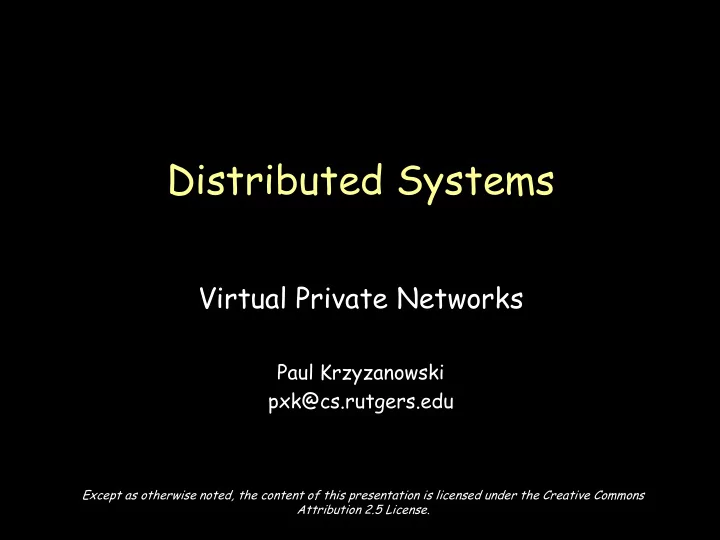

Distributed Systems Virtual Private Networks Paul Krzyzanowski pxk@cs.rutgers.edu Except as otherwise noted, the content of this presentation is licensed under the Creative Commons Attribution 2.5 License.
Private networks Problem – You have several geographically separated local area networks that you would like to have connected securely Solution – Set up a private network line between the locations – Routers on either side will be enabled to route packets over this private line
Private networks Private network line LAN A (New York) LAN B (London) • Problem: $$$¥¥¥£££ €€€ !
Virtual private networks (VPNs) Alternative to private networks – Use the public network (internet) Service appears to users as if they were connected directly over a private network – Public infrastructure is used in the connection
Building a VPN: tunneling Tunneling – Links two network devices such that the devices appear to exist on a common, private backbone – Achieve it with encapsulation of network packets
Tunneling external address: external address: 129.42.16.99 17.254.0.91 Internet LAN A (New York) LAN B (London) 192.168.1.x 192.168.2.x src: dest: data 192.168.1.10 192.168.2.32
Tunneling LAN A (New York) LAN B (London) 192.168.1.x 192.168.2.x Internet external address: external address: 129.42.16.99 17.254.0.91 - route packets for 192.168.2.x to VPN router - envelope packet - send it to remote router src: dest: src: dest: data 129.42.16.99 17.254.0.91 192.168.1.10 192.168.2.32
Tunneling LAN A (New York) LAN B (London) 192.168.1.x 192.168.2.x Internet external address: external address: 129.42.16.99 17.254.0.91 -accept packets from 129.42.16.99 -extract data (original IP packet) -send on local network src: dest: src: dest: data 129.42.16.99 17.254.0.91 192.168.1.10 192.168.2.32
Building a VPN: tunneling Operation – LAN-1 and LAN-2 each expose a single outside address and port. – A machine in the DMZ (typically running firewall software) listens on this address and port – On LAN-1, any packets addressed to LAN-2 are routed to this system. • VPN software takes the entire packet that is destined for LAN-2 and, treating it as data, sends it over an established TCP/IP connection to the listener on LAN-2 – On LAN-2, the software extracts the data (the entire packet) and sends it out on its local area network
Building a VPN: security No need to make all machines in the local area networks accessible to the public network … just the router BUT … an intruder can: – examine the encapsulated packets – forge new encapsulated packet Solution: – encrypt the encapsulated packets • Symmetric algorithm for encryption using session key – need mechanism for key exchange
IPSEC: RFC 1825, 1827 • IP-layer security mechanism • Covers authentication and encryption • Application gets benefits of network encryption without modification • Additional header added to packet: – IP Authentication header • Identifies proper source and destination – basis of point-to- point authentication • Signature for IP header • Encapsulating Security Protocol ( ESP ) • Tunnel mode: encrypt entire IP packet (data and IP/TCP/UDP headers) • or Transport mode: encrypt only IP/TCP/UDP headers (faster) • Encryption via RC4. DES. DES3, or IDEA • Key management: manual, Diffie-Hellman, or RSA
IPSEC simple tunnel src: dest: src: dest: data 129.42.16.99 17.254.0.91 192.168.1.10 192.168.2.32 with AH signature src: dest: src: dest: data 129.42.16.99 17.254.0.91 192.168.1.10 192.168.2.32 Authentication header. Validate: -Packet not modified -Packet originated from peer with AH+ESP src: dest: src: dest: data 129.42.16.99 17.254.0.91 192.168.1.10 192.168.2.32 signature
PPTP • PPTP: point-to-point tunneling protocol • Extension to PPP developed by Microsoft • Encapsulates IP, IPX, NetBEUI • Conceptually similar to IPSEC – Flawed security
The end
Recommend
More recommend